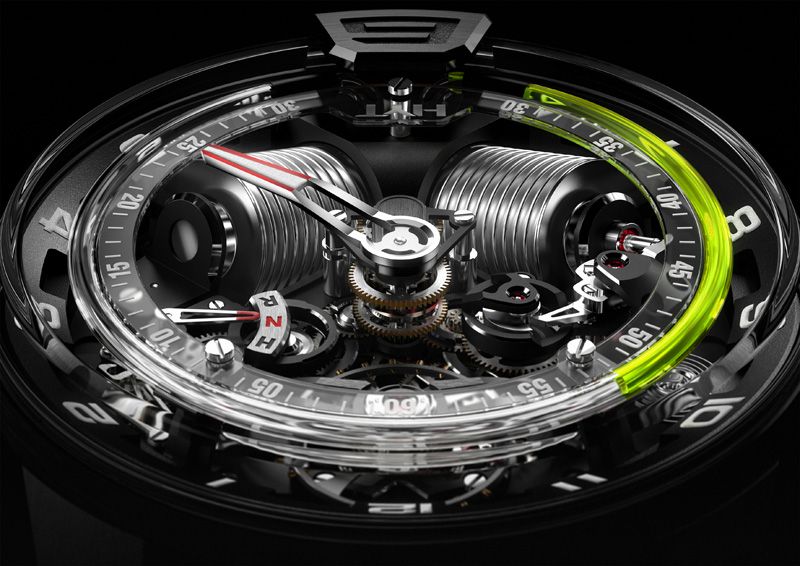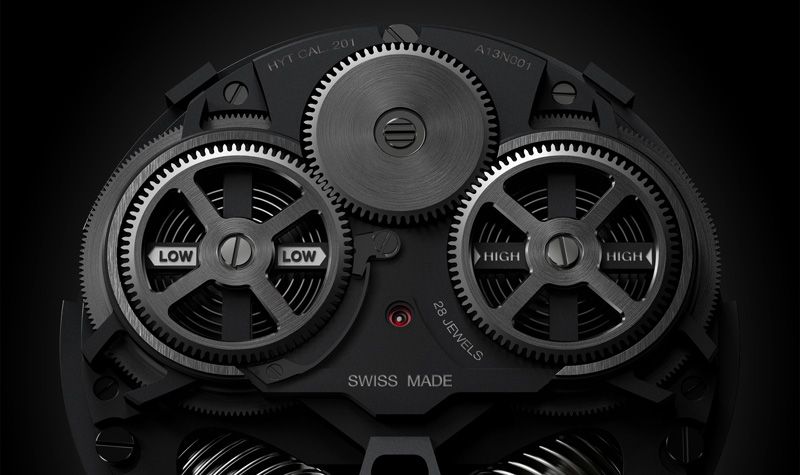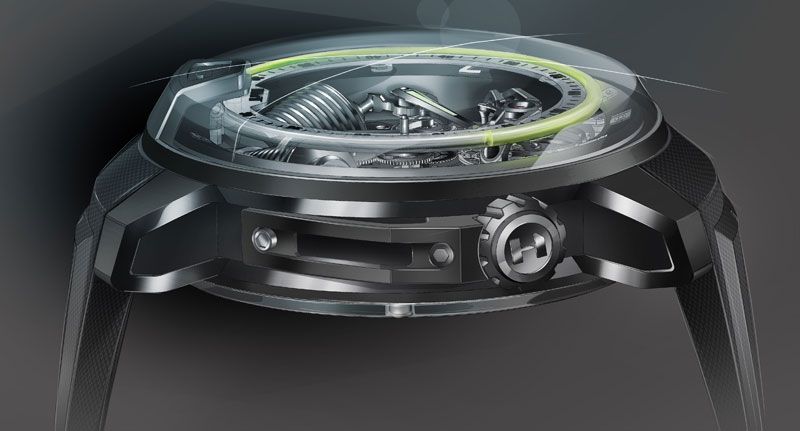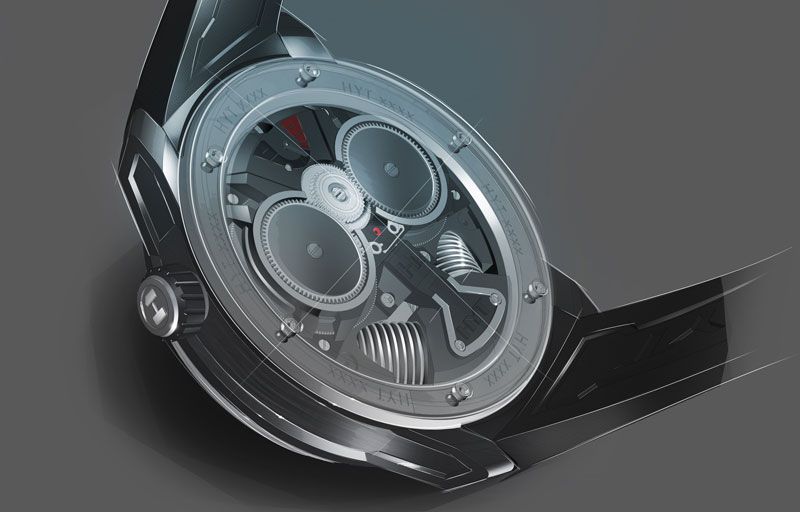HYT introduces the H2 – the Hydro Mechanical Watch gets an even more exiting Successor

After HYT put the horological world upside down with the introduction of their H1, and seduced all of us with this hydromechanical wonder, they are now launching the follow-up, named H2.
The H2 was created in cooperation with Audemars Piguet’s technical wizards of the design subsidiary Renaud et Papi, who also collaborated with Grönefeld to create their magnificent One Hertz. The H2, which is limited to just 50 pieces, and is a logical evolution, after the H1. It exposes everything it’s got on the dial, for us to admire.

I think I’ve not seen so many enthusiastic reactions on any watch launch before, so now the path of the combinations of fluids and mechanics in a timepiece has been paved, it’s the difficult task of the H2 to seduce horological connoisseurs again. And that shouldn’t be a problem, because the H2 offers a surplus over the H1.
All mechanics are fully visible, in full nudity exposed, and show how the bellows are activated every hour by a system of feelers, cams and pistons, in order to indicate the correct hour. The bellows are positioned in a “V” and remind me of the mighty engine of a Harley Davidson…

The positioning of the bellows in a V-shape optimises the integration of the interface which connects the watch mechanisms with the fluidic system. In comparison with the H1, it leaves more space so the the minute hand can be placed at center position and the balance spring resides on its black bridge, in the upper half of the dial.
The entire system of feelers, cams, pistons and many gears can be seen and there is no dial to cover this mechanical beauty. The bridges are made in titanium, covered with black PVD coating. Because the bridges have been finished before the coating, some parts are obviously sand blasted and others have been satin finished or brushed before the coating. This offers an exquisite visual play of matte and glossy black parts. Other parts like gears, feelers, pistons and the hands have not been coated black and offer a nice contrast with the black bridges and main plate.

Surrounding the dial is a sapphire chapter ring for the centrally positioned minute hand. When arrived at “30 minutes”, just before the normal 6 0’clock position, the minute hand jumps to avoid the bellow system. At the sloping edge of the “dial” are the hour numerals printed, which make it easier to read the actual hours from the hydro hour indicator.
The H2 offers three additional indicators; a power reserve indicator,a temperature indicator and a HNR indicator. The latter is connected to the crown and tells the wearer in which position the crown is. The press release didn’t mention what the HNR stands for but let’s assume it is for setting the hours (H), neutral (N) and winding (R).

Opposite is a temperature indicator, that tells the wearer whether the fluids are at the correct operation temperature. A logical indicator, as a fluid’s volume is always influenced by the temperature. So an indicator to let us know if the temperature is just right for the H2 to perfectly indicate the correct time, is a handy feature.
The H2 offers a power reserve indicator that tells how much of the 192 hours (or 8 days) of power are left in the two main spring barrels. This is another improvement over the H1, which offers 65 hours of autonomy when fully wound. The power is indicated on the two barrels, which are visible on the back side of the watch.

Conclusion
No word about the price, however I suspect it will be north of the $ 45k starting price of the H1, as it offers much more, both in visual pleasure (which has to be finished) as in functionality (8 days of power reserve). All together the H2 looks like a brilliant follow-up of the H1 and since it’s limited to just 50 pieces, I think collectors will have to move fast in order to secure one of the pieces!
Here some specifications and two cool sketches of the H2, which are exclusive for Monochrome to show you.

Collection: H2 – Limited serie to 50 pieces
Case: Black DLC titanium with polished, microblasted and satin finishes
- Diameter: 48.8 mm
- Height: 17.9 mm
- Water-resistant to 50 metres
Functions:
- Retrograde fluidic hours
- Minutes with jumping hand at 30 minutes – Crown position indicator (H-N-R)
- Temperature indicator
Movement: Mechanical with manual winding, exclusive HYT calibre
- 21,600 vib/h, 3 Hz, 28 jewels
- Titanium bridges with decorated microblasted Black PVD and titanium coloured satin-finished accents
- 192-hour (8-day) power reserve

For more info, please visit the HYT website.
This article is written by Frank Geelen, executive editor for Monochrome Watches.




7 responses
The umprecision of rate due to temperature variations still does not seem to be solved. I was told by one of the happy owner of H1 that time varies about up to 15 minutes when on or off the wrist. You write: “So an indicator to let us know if the temperature is just right for the H2 to perfectly indicate the correct time, is a handy feature.” Indeed and H1 should had have one… but what shall a user do when the temperature is “wrong”? Does he have to add or remove a few minutes (like for an equation of time)? Does a concept that cannot display time properly not disqualify itself? A pure gimmick should at least funktion right as it does not add any usefull function. It took watchmakers centuries to make watches which are resistant/compensate temperature variations… Isn’t it ironic?
It’s a good sign that HYT recognized the problem and already came with a solution so fast. Developing something so new and groundbreaking like this isn’t easy and I think buyers of the H1 should be aware of the fact that they are part of history being made. It’s not that the watch runs fast/slow, it’s just the fluid that is sometimes a bit too much expanded, but once at the proper temperature it will of course indicate the correct time again.
Dear Frank
I have the deepest respect for your blog (and opinions) which I read almost everyday. But I cannot understand how you can defend a watch that does not (always) display time precisely (a variation of 15 minutes is just huge). On the one hand you seem to be a big fan of watches with force constante (ultimate precision) and on the other hand you also defend a watch which clearly lacks of any chronometric precision. I find it also strange that watch engineers did not think about dilatation first and realize this fact/problem (only) after releasing/selling the first watches. It seems also strange to qualify something as “groundbreaking” that does make a watch function worse. A lot of things have been tried in watchmaking and abandoned because they just did not work. As it is just fun/new to display time with a liquid, I do not understand why someone should do so if it does not display time correctly (or at least at certain temperatures). My impression is that it just went wrong and that someone decided to sell it anyway… At the end customers will have to decide if they find it fun to have a watch that is not always precise. At least the owner I know seems to have accepted it…
Best,
Jack
Dear Jack,
First of all, thank you for the compliment.
About the HYT H2, I think we need to keep apart the chronometric rates and the display of hours. The mechanical part of the movement is not influenced by temperature fluctuations, and thus should always indicate the time correct.
The problem is the fluid that is influenced by temperature fluctuations. When the watch is at the right temperature range, it will indicate the correct time. When the temperature is too high or too low, the exact indication is indeed influenced. I’m not defending this, but I still think it’s a very cool timepiece.
As you maybe know I’m a huge fan of watches made by URWERK, MB&F, Hautlence and Ladoire. These watches will indicate the time properly, however reading time is not as easy and fast as on a simple three hand watch. So that’s why I’m maybe slightly easy ‘forgive’ HYT for this imperfection.
Thanks for you feedback!
Frank
dear Jack,
Allow me jump in the discussion, and firstly to thank you for having looked into our brand with a critical eye.
When “off” the wrist the fluid might indeed expand or retract, this is true and was never hidden, it is explained in the user manual and we relayed this info to all our partners. The capillary being less than 1 mm diameter, and the fluid quantities being very small, 1 micron fluidic move corresponds to several “minutes” on the hour marker (never on the minute hand of course). Therefore if for example the watch is left not worn in the sun or left in the fridge (for the sake of the example) we will have a fluid moving either slightly up or down. This being said, the mechanical accuracy is never influenced…. And yes, once worn again, the fluid gets to the right position. Accuracy is critical for us as for any other brand, no question about it! In order to avoid these fluidic differences when “on” and “off” the wrist, and acknowledging the confusion that might arise, I gladly announce…and this is almost a Monochrome scoop, the introduction on H1 of a new device acting as thermical compensator. To make a long story short, this device acts directly on the bellows, as a counterbalance to the thermic action on the fluid, i.e. contracts when fluid would expand, and the opposite. Of course the H2 would have this device too. The additional thermical indicator on the H2 is giving the temperature indication “in” the watch, not the external temperature. Therefore it will be a complement to the above mentioned mechanical improvements. The temperature cannot be “wrong” as you imply, or better said, the only action to perform will be to wear the watch. Thank you for interest. Warm regards, Ion
Beautiful, but 45k for a watch that might tell the correct time under correct temperature conditions! ridiculous joke. Good luck.
How can you defend a watch that does not accurately tell the time and is simply over-priced.
A glass hammer may well be a beautiful objet d’art but it fails at being a hammer. The sake of innovation purely for innovation is fine but not when being charged 45k for a non-functional vanity piece.
Disappointed you have chosen to herald this piece. I feel perhaps you are over exaggerating its technology. Water clocks are as old as time, inaccuracy of this magnitude is unforgivable.